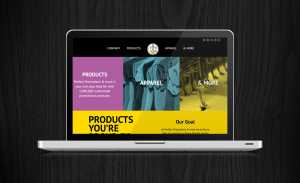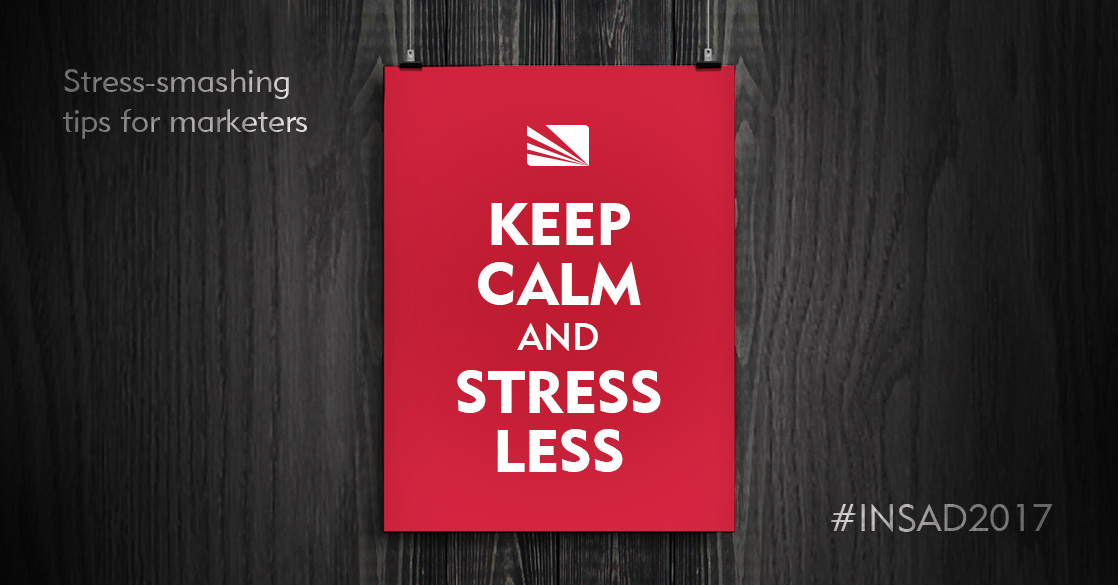Marketers, you can cross these 3 things off your stress list
You seem a little stressed. Maybe your work-life balance skews too far in one direction. Or else this whole modern marketer deal of being part artist, part scientist is splitting you in two.
National Stress Awareness Day goes international on November 1, and what better time to reflect on the night-sweats worthy stress factors you deal with as a marketer.
You might find the following stressors aren’t as bad as you thought. You won’t even need to resort to exercise or deep breathing to get relief.
 Stress Factor 1: Your budget gives you a migraine
Stress Factor 1: Your budget gives you a migraine
Stressing about your marketing budget goes with the territory. We’ve all been there.
Here’s some good news, bad news: marketing budgets among large companies are trending up this year, climbing to 12% of company revenue, according to the Gartner 2016-2017 CMO Spend Survey. But those marketers still face pressure to balance competing priorities.
Technology investments for digital marketing remain a top priority, according to the Gartner survey. But long-term improvements to the customer experience compete for budget dollars, too.
Meanwhile, marketers at smaller businesses struggle to make an impact on a shoe-string budget. The temptation to opt for short-term purchases can be strong, but investing the time and resources to create consistent messaging has longer-term brand impact.
Stress relief:
Consider this advice from the Smarter with Gartner Marketing Blog as aromatherapy for your budget headaches:
- Think long term and plan accordingly. Smarter with Gartner Contributor Chris Pemberton warns against a short-term mindset and says instead to “balance your spending between short-term tactics and initiatives that can bring long-term improvements to the customer experience and brand-building efforts.”
- Rebalance your in-house/outsource talent mix. In the new world of work, using a blended workforce brings greater flexibility and industry expertise on demand. Pemberton says: “Explore outsourced capabilities you can bring in-house to reduce costs and increase internal competencies. Also look to see if there are any in-house activities that could be more efficient if they were outsourced.” (We recommend the latter.)
Real-world application:
 MR Williams started 30 years ago as a convenience store supplier serving a 50-mile wide territory. They grew to become one of the top 50 distributors in the country.
MR Williams started 30 years ago as a convenience store supplier serving a 50-mile wide territory. They grew to become one of the top 50 distributors in the country.
This evolution meant the company’s branding and marketing materials had to keep pace, but within do-able budget parameters.
Lightspeed advised them to make the most of their marketing dollars by focusing on rebranding efforts that would bring long-term benefits:
- a holistic approach to their messaging, vision and brand
- a marketing plan to define their brand and what makes them stand out from their competition
- consistent messaging to use across their website and collateral pieces.
 Stress Factor 2: Your brand’s lovable but misunderstood
Stress Factor 2: Your brand’s lovable but misunderstood
Branding your business and building a company are two things that go together even more than Halloween and David S. Pumpkins – and make a lot more sense. Any questions?
In 7 Principles To Building A Strong Brand, Forbes Contributor and Studio 15 CEO Jia Wertz says:
“(Branding) gives your company a unique personality, and establishes a differentiated position in the market that attracts the right customers.”
But what if your brand feels like a teenager who thinks the world just doesn’t get her? Then it’s time to stop stressing and start asking yourself why.
Best-selling author Simon Sinek popularized the concept of “why” in his leadership book, “Start With Why” and Ted Talk, How Great Leaders Inspire Action (now with nearly 35 million views).
Sinek says companies that have extraordinary success are those that start with the core belief of why their business exists. He adds:
A “why” is not something we change when it suits us. …We can pivot product offerings. We can pivot marketing approach. We can pivot a business strategy. It is the “why” that provides solidity and continuity. It is like the foundation of a house. Renovate the house as you see fit — but the foundation remains fixed.”
Stress relief:
You’ll feel better with some self-reflection therapy. Take the time to ask yourself some big questions of your brand:
Why does your brand exist?
How would you describe your brand’s personality traits as if it were a person?
What are some misconceptions about your brand?
Once you’re clear in your own mind about the purpose and personality of your business, it’s easier to communicate your brand so people will get you.
Real-world application:
Perfect Promotions & more , a North Carolina-based promotional product and apparel company, acts as an extension of their client’s marketing team, overseeing client needs from order to invoice. The “& more” covers related services such as setting up employee recognition programs.
, a North Carolina-based promotional product and apparel company, acts as an extension of their client’s marketing team, overseeing client needs from order to invoice. The “& more” covers related services such as setting up employee recognition programs.
Not going to be misunderstood as just a swag vendor, their team needed a website that communicated their value proposition, newly updated messaging and the full extent of what they do for clients.
A company’s website is often the first glimpse potential customers get at what you can do. We made sure theirs captured the personality and scope of their brand to make a great first impression.
 Stress Factor 3: You want to make an emotional connection without coming on too strong
Stress Factor 3: You want to make an emotional connection without coming on too strong
We won’t cover all the research and conclusions about customers’ emotional decision-making. Just accept it’s a thing, and marketers stress about it
Forbes Coaches Council recommends marketers make emotional connections in the simplest ways possible, to break through the noise and reach and keep their customers.
In branding, like on a date, you don’t want to appear needy, share too much or cross a line.
Stress relief:
The simplest way to make an emotional connection is to be yourself. Genuine and authentic.
Use these tips to make it easier for people to emotionally connect with your brand:
- Show you care. The majority of consumers (65%) say they feel most emotionally connected with brands that come across as caring about people like themselves, according to recent research from Customer Thermometer. Forbes Coaches Council member Shawn Graham says:
(Treat) every touchpoint with your customers like a face-to-face conversation. What information would you share? How would you talk about your products? Would you be smiling? Consumers have a lot of choices. It’s your job as a marketer to give them a reason to care.”
- Use the emotional power of visuals and video. Our brains are wired for visual signals and respond to the lasting impressions visuals can make. Video storytelling not only has exceptional recall power, but also the ability to leave us teary-eyed from either crying or laughing (sometimes both).
Real-world application:
 We can’t think of a more powerfully emotional project we’ve experienced than the video we co-produced for the Triangle Chapter of The American Heart Association.
We can’t think of a more powerfully emotional project we’ve experienced than the video we co-produced for the Triangle Chapter of The American Heart Association.
This survivor story video for the Triangle Go Red for Women campaign did more than promote the good work done by the AHA. The video became a call-to-action for women everywhere – with one woman’s inspirational story of hope, perseverance and awareness.
How we destress
We were going to ask Team Lightspeed members to share ways they destress, with cool hobbies and what not. But the pressure to provide clever answers stressed them out.
We’ll just go with pumpkin-carving.
For more about how we help relieve stress for our clients, read Our Work.






